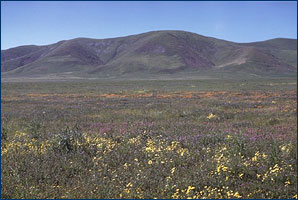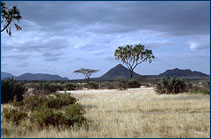Grasslands are characterized as lands dominated by grasses rather than
large shrubs or trees. In the Miocene and Pliocene Epochs, which spanned
a period of about 25 million years, mountains rose in western North
America and created a continental climate favorable to grasslands.
Ancient forests declined and grasslands became widespread. Following the
Pleistocene Ice Ages, grasslands expanded in range as hotter and drier
climates prevailed worldwide. There are two main divisions of
grasslands:

A grassland west of Coalinga, California.
- Tropical grasslands or savannas
- Temperate grasslands
Savanna
Savanna is grassland with scattered individual trees. Savannas of one
sort or another cover almost half the surface of Africa (about five
million square miles, generally central Africa) and large areas of
Australia, South America, and India. Climate is the most important
factor in creating a savanna. Savannas are always found in warm or hot
climates where the annual rainfall is from about 50.8 to 127 cm (20-50
inches) per year. It is crucial that the rainfall is concentrated in six
or eight months of the year, followed by a long period of drought when
fires can occur. If the rain were well distributed throughout the year,
many such areas would become tropical forest. Savannas which result from
climatic conditions are called
climatic savannas.
Savannas that are caused by soil conditions and that are not entirely maintained by fire are called
edaphic savannas.
These can occur on hills or ridges where the soil is shallow, or in
valleys where clay soils become waterlogged in wet weather. A third type
of savanna, known as
derived savanna, is the result of people
clearing forest land for cultivation. Farmers fell a tract of forest,
burn the dead trees, and plant crops in the ashes for as long as the
soil remains fertile. Then, the field is abandoned and, although forest
trees may recolonize, grass takes over on the bare ground (succession),
becoming luxuriant enough to burn within a year or so. In Africa, a
heavy concentration of elephants in protected parkland have created a
savanna by eating leaves and twigs and breaking off the branches,
smashing the trunks and stripping the bark of trees. Elephants can
convert a dense woodland into an open grassland in a short period of
time. Annual fires then maintain the area as a savanna.
 |

Savanna in the Samburu Game Preserve, Kenya.
|
The soil of the savanna is porous, with rapid drainage of water. It has
only a thin layer of humus (the organic portion of the soil created by
partial decomposition of plant or animal matter), which provides
vegetation with nutrients. Savannas are sometimes classified as forests.
The predominant vegetation consists of grasses and forbs (small
broad-leaved plants that grow with grasses). Different savannas support
different grasses due to disparities in rainfall and soil conditions.
Because the savanna supports such a large number of species competing
for living space, usually only one or a few kinds of grass are more
successful than the others in a particular area. For example, in drier
savannas such as those on the Serengeti plains or Kenya's Laikipia
plateau, the dominant grasses on well-drained soils are Rhodes grass and
red oat grass; throughout the East African savannas, star grasses are
dominant; the lemon grasses are common in many western Uganda savannas.
Temperate grassland:
 |

Colorado prairie.
|
Temperate grasslands are characterized as having grasses as the dominant
vegetation. Trees and large shrubs are absent. Temperatures vary more
from summer to winter, and the amount of rainfall is less in temperate
grasslands than in savannas. The major manifestations are the veldts of
South Africa, the puszta of Hungary, the pampas of Argentina and
Uruguay, the steppes of the former Soviet Union, and the plains and
prairies of central North America. Temperate grasslands have hot summers
and cold winters. Rainfall is moderate. The amount of annual rainfall
influences the height of grassland vegetation, with taller grasses in
wetter regions. As in the savanna, seasonal drought and occasional fires
are very important to biodiversity. However, their effects aren't as
dramatic in temperate grasslands as they are in savannas. The soil of
the temperate grasslands is deep and dark, with fertile upper layers. It
is nutrient-rich from the growth and decay of deep, many-branched grass
roots. The rotted roots hold the soil together and provide a food
source for living plants. Each different species of grass grows best in a
particular grassland environment (determined by temperature, rainfall,
and soil conditions). The seasonal drought, occasional fires, and
grazing by large mammals all prevent woody shrubs and trees from
invading and becoming established. However, a few trees, such as
cottonwoods, oaks, and willows grow in river valleys, and some nonwoody
plants, specifically a few hundred species of flowers, grow among the
grasses. The various species of grasses include purple needlegrass, blue
grama, buffalo grass, and galleta. Flowers include asters, blazing
stars, coneflowers, goldenrods, sunflowers, clovers, psoraleas, and wild
indigos.
Precipitation in the temperate grasslands usually occurs in the late
spring and early summer. The annual average is about 50.8 to 88.9 cm
(20-35 inches). The temperature range is very large over the course of
the year. Summer temperatures can be well over 38° C (100 degrees
Fahrenheit), while winter temperatures can be as low as -40° C (-40
degrees Fahrenheit).
The fauna (which do not all occur in the same temperate grassland)
include gazelles, zebras, rhinoceroses, wild horses, lions, wolves,
prairie dogs, jack rabbits, deer, mice, coyotes, foxes, skunks, badgers,
blackbirds, grouses, meadowlarks, quails, sparrows, hawks, owls,
snakes, grasshoppers, leafhoppers, and spiders.
There are also environmental concerns regarding the temperate
grasslands. Few natural prairie regions remain because most have been
turned into farms or grazing land. This is because they are flat,
treeless, covered with grass, and have rich soil.
Temperate grasslands can be further subdivided.
Prairies are grasslands with tall grasses while
steppes
are grasslands with short grasses. Prairie and steppes are somewhat
similar but the information given above pertains specifically to
prairies — the following is a specific description of steppes.
Steppes are dry areas of grassland with hot summers and cold winters.
They receive 25.4-50.8 cm (10-20 inches) of rainfall a year. Steppes
occur in the interiors of North America and Europe. Plants growing in
steppes are usually greater than 1 foot tall. They include blue grama
and buffalo grass, cacti, sagebrush, speargrass, and small relatives of
the sunflower. Steppe fauna includes badgers, hawks, owls, and snakes.
Today, people use steppes to graze livestock and to grow wheat and other
crops. Overgrazing, plowing, and excess salts left behind by irrigation
waters have harmed some steppes. Strong winds blow loose soil from the
ground after plowing, especially during droughts. This causes the dust
storms of the Great Plains of the U.S.


